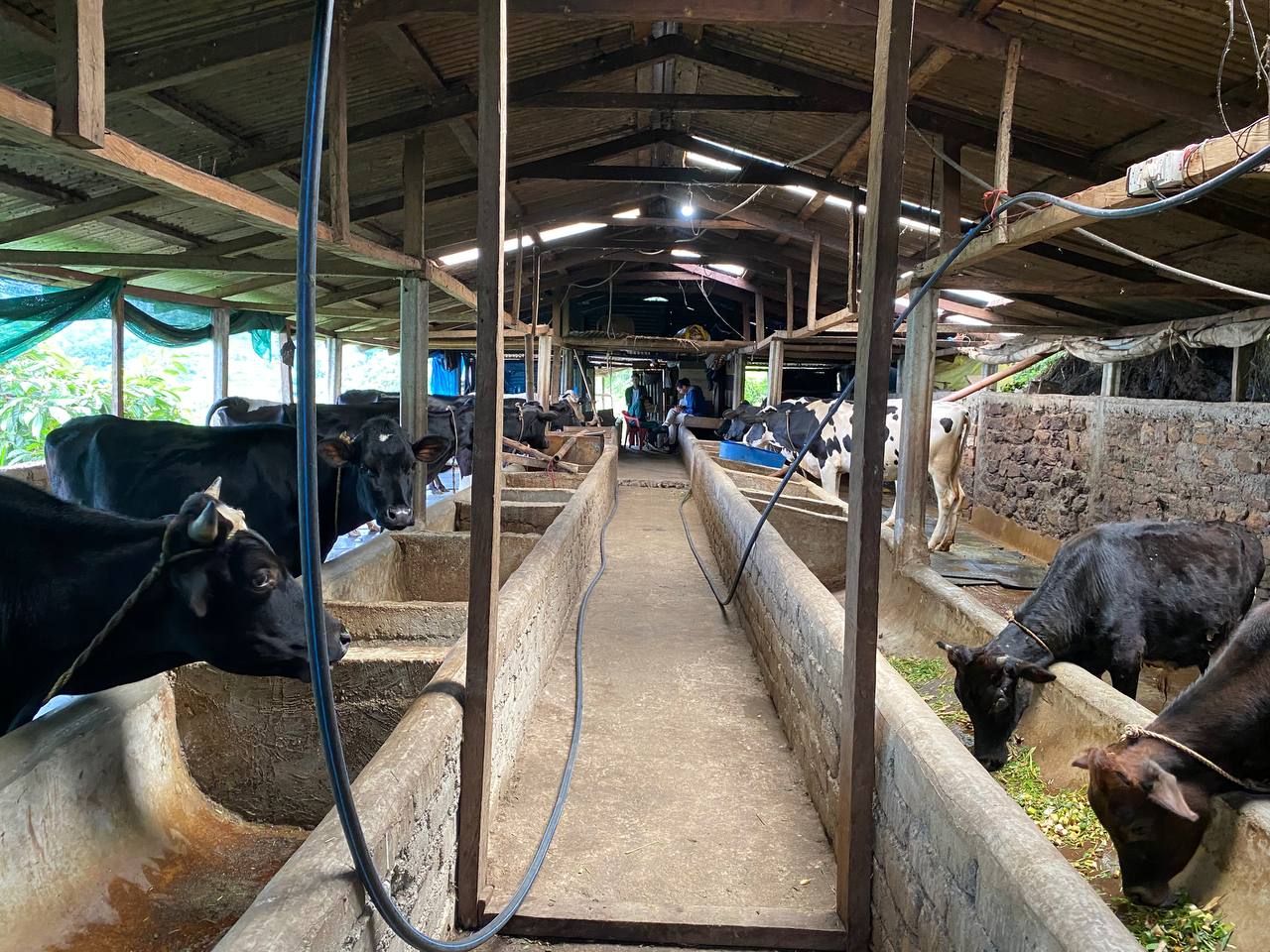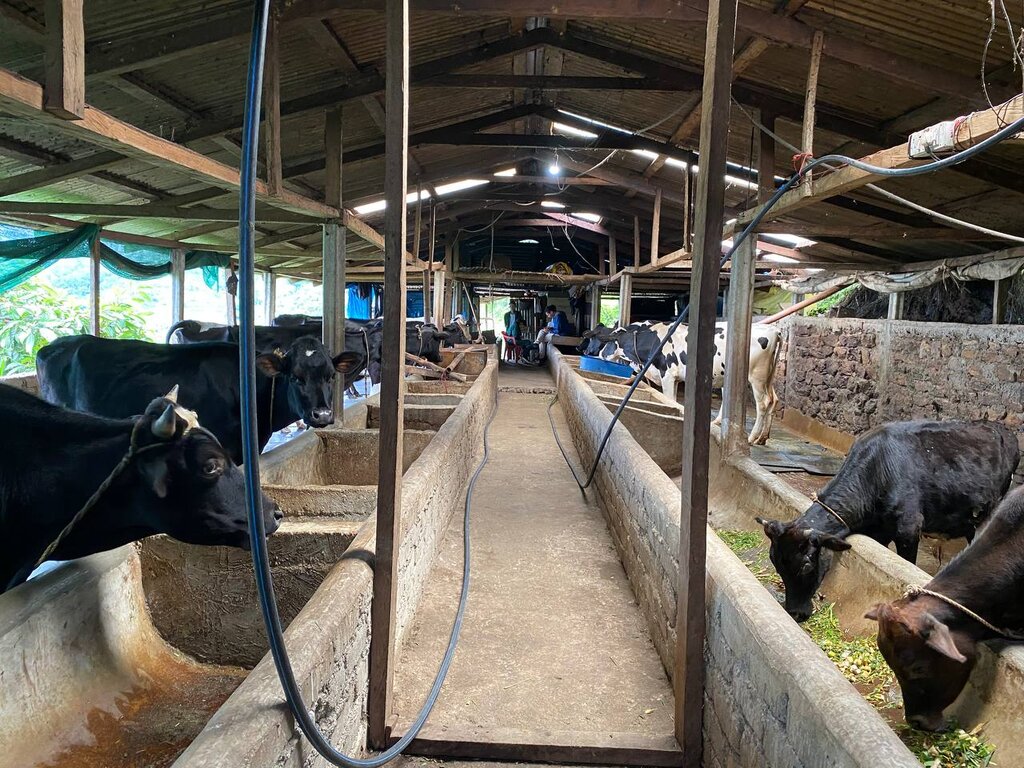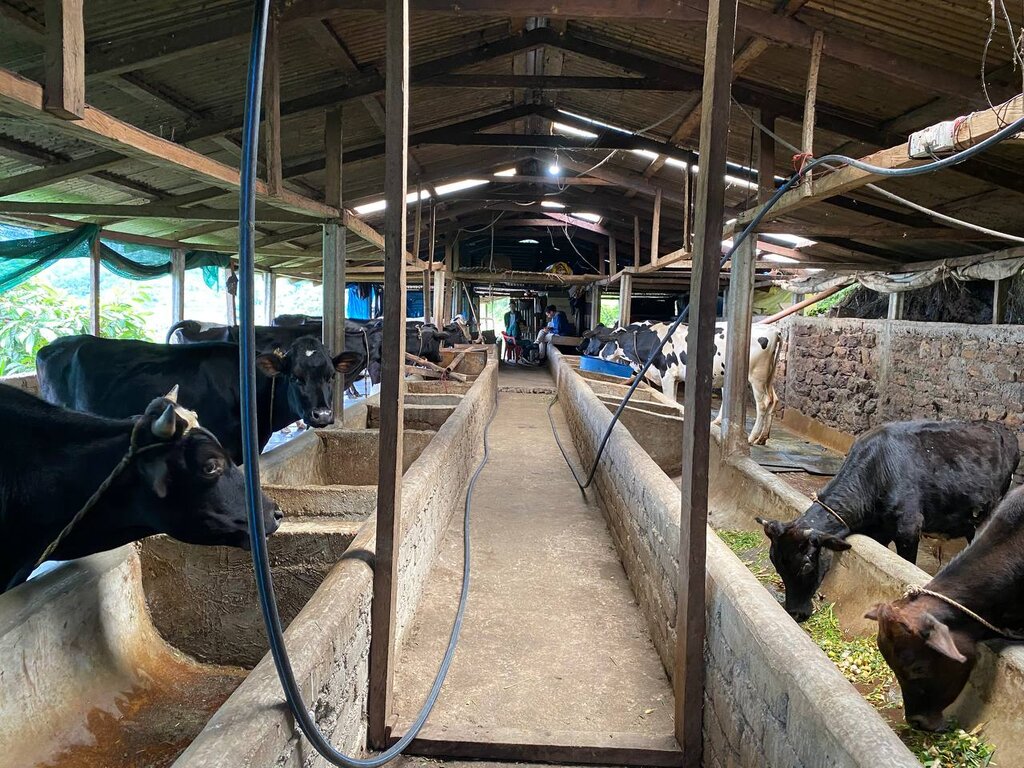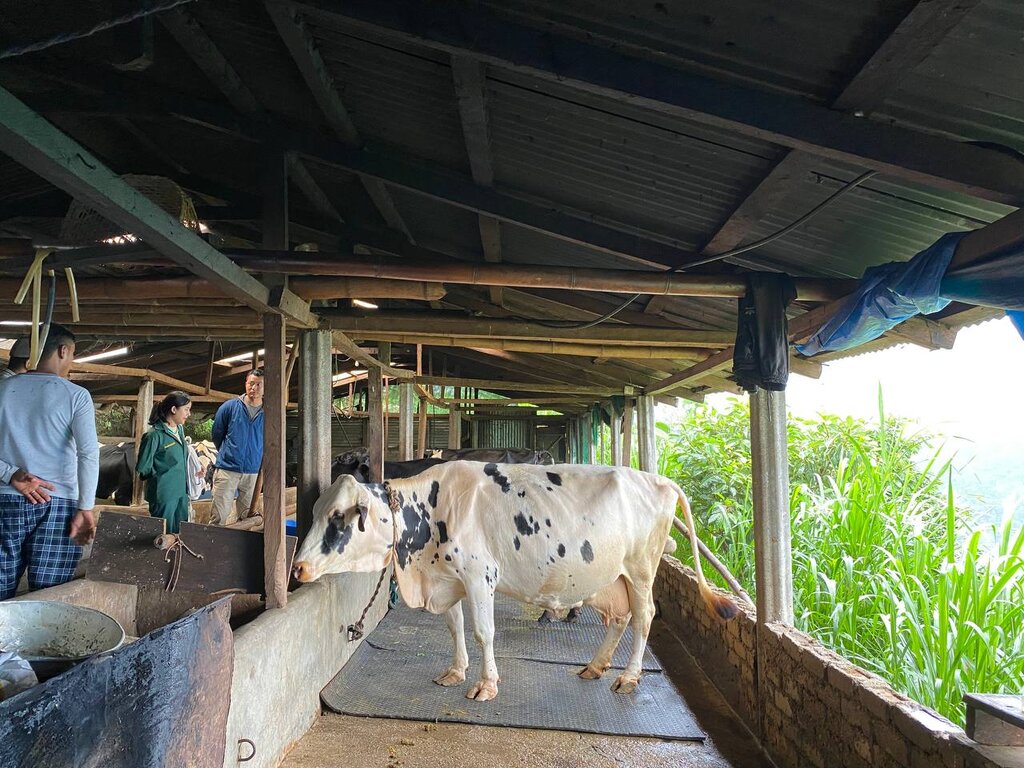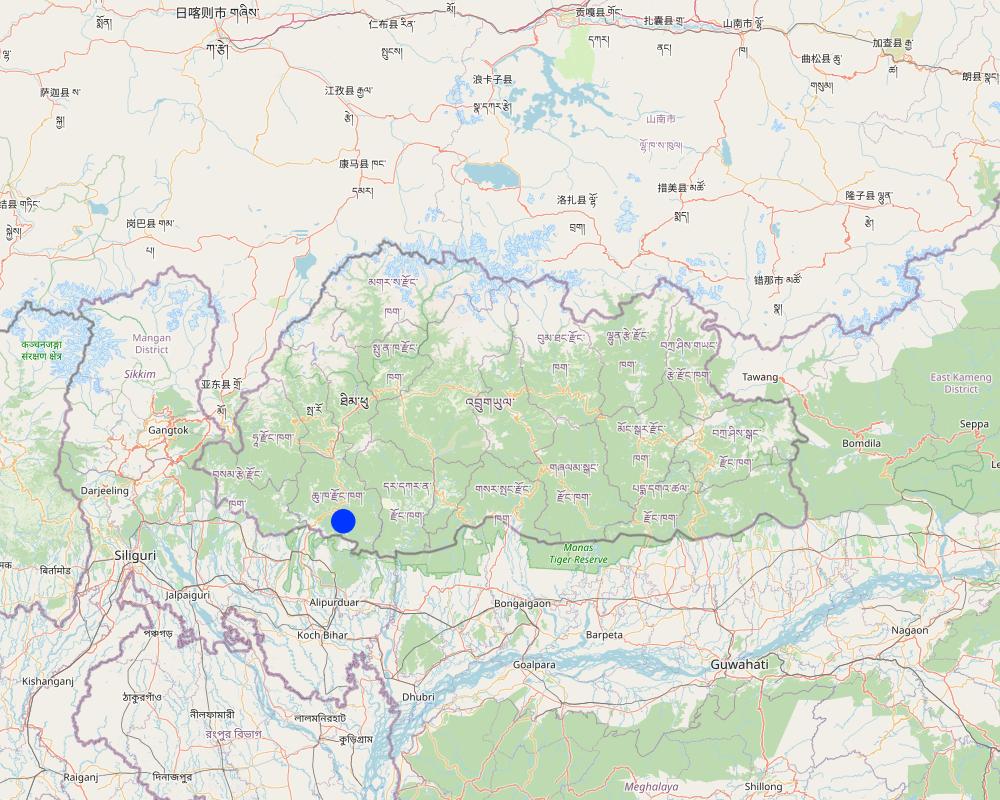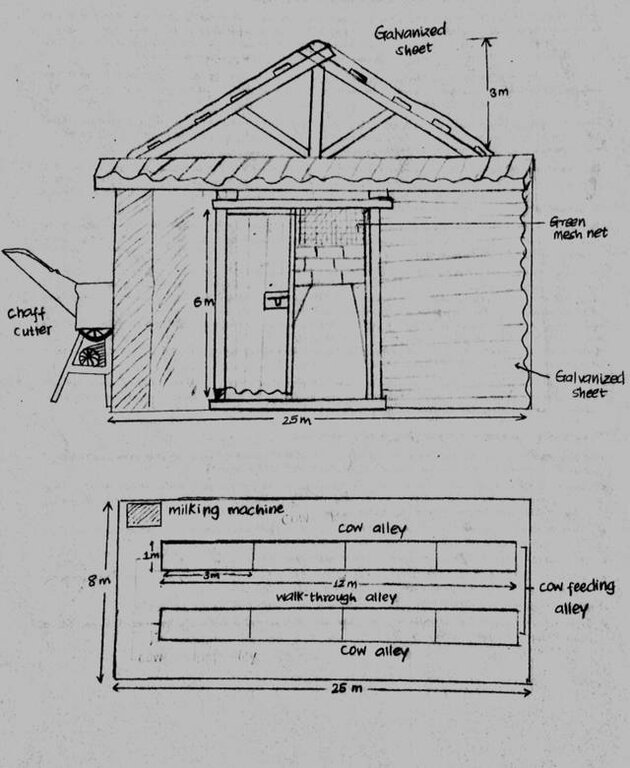Stall-Feeding of Dairy Cows [Bhutan]
- Creation:
- Update:
- Compiler: Karma Wangdi
- Editor: Tashi Wangdi
- Reviewers: William Critchley, Rima Mekdaschi Studer, Joana Eichenberger
Tsa Chhag Jin Tey Nor So Chong (རྩ་ཆག་བྱིན་སྟེ་ནོར་གསོ་སྐྱོང་།)
technologies_6869 - Bhutan
View sections
Expand all Collapse all1. General information
1.2 Contact details of resource persons and institutions involved in the assessment and documentation of the Technology
Key resource person(s)
land user:
Chettri Hemlal
Arekha, Darla Gewog (Block), Chhukha Dzongkag (District)
Bhutan
Name of project which facilitated the documentation/ evaluation of the Technology (if relevant)
Strengthening national-level institutional and professional capacities of country Parties towards enhanced UNCCD monitoring and reporting – GEF 7 EA Umbrella II (GEF 7 UNCCD Enabling Activities_Umbrella II)1.3 Conditions regarding the use of data documented through WOCAT
The compiler and key resource person(s) accept the conditions regarding the use of data documented through WOCAT:
Ja
1.4 Declaration on sustainability of the described Technology
Is the Technology described here problematic with regard to land degradation, so that it cannot be declared a sustainable land management technology?
Nee
Comments:
This technology does not have any problem with regard to land degradation
2. Description of the SLM Technology
2.1 Short description of the Technology
Definition of the Technology:
Stall-feeding is an improved cattle production system, which is increasingly being adopted with a growing population of high yielding exotic dairy breeds. Thus, most improved dairy cattle in Nepal are being reared under confinement with limited access to grazing, as it allows for easy and optimal supplementation of fodder.
2.2 Detailed description of the Technology
Description:
Stall-feeding, or “zero-grazing”, is a livestock management approach that confines animals within stalls or pens for feeding. It offers various advantages, such as improved waste management, precise nutrition control, and reduced risk of overgrazing. It allows farmers to carefully regulate their animals' diets to ensure they receive the necessary nutrition for optimal growth and productivity (Hadush, 2002). To effectively implement stall-feeding, several key components are required. Firstly, animals must be housed in separate stalls of appropriate size to facilitate cleaning and waste collection. Secondly, a well-planned feeding system is essential, which may involve the use of automatic feeding equipment, or alternatively manual distribution of hay, grains, and supplements tailored to each breed’s unique nutritional needs. Thirdly, a comprehensive waste management system is crucial to handle the manure produced by confined animals, which involves thorough stall cleaning and composting, transforming waste into organic fertilizer. Proper water supply and ventilation are also imperative for the animals' health and well-being. Adhering to these technical requirements (Garber, 2010) ensures optimal productivity and animal welfare in the stall-feeding system.
Stall-feeding is employed in various agricultural contexts worldwide, particularly where traditional open grazing is impractical or unsustainable. It is applied in areas with limited grazing land and high population density, such as urban and peri-urban settings. Moreover, it may be used in arid or semi-arid regions with scarce natural pastures, as well as during dry seasons when grazing resources are scarce. Smallholder farms and intensive livestock production systems aim to maximize output while optimizing resource usage, making stall feeding a prevalent practice. Dairy farming employs stall-feeding to boost milk production and enhance the quality of dairy products (Oosting et al., 2021).
According to Sahoo et al. (2015), the primary objective of stall-feeding is to provide controlled and ideal conditions for managing and feeding cattle. This approach ensures that animals are housed indoors according to their age, sex, breed, and weight, preventing them from grazing outdoors. To establish a well-functioning system, several crucial steps must be taken. First and foremost is the construction of individual stalls or pens, with careful consideration of size and design to accommodate different animals comfortably. The implementation of a reliable and well-planned feeding strategy is equally crucial. Adequate water supply and optimal ventilation within the stalls are also vital considerations (Van Eerdenburg & Ruud, 2021).
One of the primary advantages of stall feeding is its ability to provide animals with controlled and balanced nutrition, resulting in improved growth rates and higher-quality products like milk or meat. It also aids in disease prevention and mitigates the environmental impact of overgrazing. However, the main drawback lies in the additional effort and expense associated with feeding, cleaning, and waste management. Improperly managed confinement can limit animals' freedom of movement, potentially affecting their behavioral and psychological well-being. Proper ventilation and hygiene within the stalls are essential to address these concerns (Sahoo et al., 2015).
The type of fodder grown for dairy cattle primarily includes a variety of grasses and legumes suitable for the region's climate and terrain. Common fodder crops grown for dairy farming include Napier grass (Pennisetum purpureum), Rhodes grass (Chloris gayana), Alfalfa (Medicago sativa), Clover (Trifolium spp.), Ryegrass (Lolium spp.) sorghum (Sorghum bicolor). Additionally, Bhutan's traditional agroecological practices may also involve grazing on natural pastures and feeding on crop residues such as maize stalks and rice straw.
In Bhutan, traditional cattle breeds such as the Jersey, Brown Swiss, and local breeds are commonly raised for milk production. The milk yield per cow varies significantly based on factors such as breed genetics, nutrition, health, and management practices. On average, dairy cows in Bhutan may produce anywhere from 5 to 10 liters of milk per day, although some high-yielding breeds or well-managed farms may achieve higher yields. However, it's essential to note that these figures are approximate and can vary widely.
2.3 Photos of the Technology
2.5 Country/ region/ locations where the Technology has been applied and which are covered by this assessment
Country:
Bhutan
Region/ State/ Province:
Chukha
Further specification of location:
Arekha, Darla,
Specify the spread of the Technology:
- applied at specific points/ concentrated on a small area
Is/are the technology site(s) located in a permanently protected area?
Nee
Comments:
n/a
Map
×2.6 Date of implementation
Indicate year of implementation:
2016
If precise year is not known, indicate approximate date:
- less than 10 years ago (recently)
2.7 Introduction of the Technology
Specify how the Technology was introduced:
- through land users' innovation
- through projects/ external interventions
Comments (type of project, etc.):
Stall-feeding technology was adopted for rearing Holstein Fresian cattle, with fund (low interest loan) supports from Rural Enterprise Development Corporation Limited/Cottage and Small Industry
3. Classification of the SLM Technology
3.1 Main purpose(s) of the Technology
- improve production
- reduce, prevent, restore land degradation
- reduce risk of disasters
- create beneficial economic impact
3.2 Current land use type(s) where the Technology is applied

Grazing land
Intensive grazing/ fodder production:
- Cut-and-carry/ zero grazing
Animal type:
- cattle - dairy
Is integrated crop-livestock management practiced?
Nee
Products and services:
- manure as fertilizer/ energy production
Species:
cattle - dairy
Count:
18
3.3 Has land use changed due to the implementation of the Technology?
Has land use changed due to the implementation of the Technology?
- Yes (Please fill out the questions below with regard to the land use before implementation of the Technology)
Land use mixed within the same land unit:
Nee

Grazing land
Extensive grazing:
- Semi-nomadic pastoralism
- Ranching
Animal type:
- cattle - dairy
Is integrated crop-livestock management practiced?
Ja
If yes, specify:
Grows fodder
Products and services:
- manure as fertilizer/ energy production
Species:
cattle - dairy
Count:
18
Comments:
16 Holstein Friesian and 2 Jersey cattle
3.4 Water supply
Water supply for the land on which the Technology is applied:
- mixed rainfed-irrigated
Comments:
The farm has independent water source.
3.5 SLM group to which the Technology belongs
- integrated crop-livestock management
- improved plant varieties/ animal breeds
- energy efficiency technologies
3.6 SLM measures comprising the Technology

structural measures
- S9: Shelters for plants and animals

management measures
- M1: Change of land use type
- M2: Change of management/ intensity level
- M3: Layout according to natural and human environment
3.7 Main types of land degradation addressed by the Technology

soil erosion by water
- Wm: mass movements/ landslides

biological degradation
- Bc: reduction of vegetation cover
Comments:
He grows fodder nearby his dairy farm increasing the vegetation.
3.8 Prevention, reduction, or restoration of land degradation
Specify the goal of the Technology with regard to land degradation:
- prevent land degradation
4. Technical specifications, implementation activities, inputs, and costs
4.1 Technical drawing of the Technology
4.2 General information regarding the calculation of inputs and costs
Specify how costs and inputs were calculated:
- per Technology unit
Specify unit:
Stall-feed unit
Specify dimensions of unit (if relevant):
approx 3500 metres squared (Stall-Feeding unit)
other/ national currency (specify):
Ngultrum
If relevant, indicate exchange rate from USD to local currency (e.g. 1 USD = 79.9 Brazilian Real): 1 USD =:
80.0
Indicate average wage cost of hired labour per day:
500
4.3 Establishment activities
| Activity | Timing (season) | |
|---|---|---|
| 1. | Site selection (Near the road) | Winter |
| 2. | Gathered raw materials | winter |
| 3. | Construction of shelter | winter |
| 4. | Construction of individual stalls with proper size and design to comfortably accommodate the cattles | winter |
| 5. | Set up a dependable and well thought feeding strategy | winter |
| 6. | Roofing of the stalls with CGI sheets | winter |
| 7. | Installation of proper ventilation for cattles | winter |
| 8. | Installing of water pumps to clean the areas | winter |
| 9. | Installing of miliking machine and chaff cutter | winter |
Comments:
The dairy shed was constructed in April, 2016
4.4 Costs and inputs needed for establishment
| Specify input | Unit | Quantity | Costs per Unit | Total costs per input | % of costs borne by land users | |
|---|---|---|---|---|---|---|
| Labour | labor | per head | 150.0 | 500.0 | 75000.0 | 100.0 |
| Equipment | Spade | numbers | 10.0 | 300.0 | 3000.0 | |
| Equipment | Crowbar | numbers | 10.0 | 500.0 | 5000.0 | |
| Construction material | Cement | bags | 50.0 | 390.0 | 19500.0 | 100.0 |
| Construction material | CGI sheet | number | 117.0 | 750.0 | 87750.0 | 100.0 |
| Construction material | iron rod | piece | 14.0 | 600.0 | 8400.0 | 100.0 |
| Construction material | Bricks | piece | 1000.0 | 7.0 | 7000.0 | 100.0 |
| Construction material | Stones | trucks | 16.0 | 6700.0 | 107200.0 | 100.0 |
| Construction material | Wood | CFT | 250.0 | 450.0 | 112500.0 | 100.0 |
| Other | Cattle | numbers | 8.0 | 75000.0 | 600000.0 | 100.0 |
| Other | Chaff cutter | number | 1.0 | 50000.0 | 50000.0 | 100.0 |
| Other | milking machine | number | 1.0 | 35350.0 | 35350.0 | 100.0 |
| Other | water pump | number | 1.0 | 8000.0 | 8000.0 | 100.0 |
| Total costs for establishment of the Technology | 1118700.0 | |||||
| Total costs for establishment of the Technology in USD | 13983.75 | |||||
Comments:
The owner bore all the cost by himself except for the 2 Jersey and 3 Holstein Friesen which was supported by department of livestock, Ministry of Agriculture and LIvestock
4.5 Maintenance/ recurrent activities
| Activity | Timing/ frequency | |
|---|---|---|
| 1. | Floor cracking repair | December, 2020 |
Comments:
Maintenance cost was bored by the owner
4.6 Costs and inputs needed for maintenance/ recurrent activities (per year)
| Specify input | Unit | Quantity | Costs per Unit | Total costs per input | % of costs borne by land users | |
|---|---|---|---|---|---|---|
| Labour | Helper | per head | 30.0 | 500.0 | 15000.0 | 100.0 |
| Construction material | cement | bags | 8.0 | 390.0 | 3120.0 | 100.0 |
| Total costs for maintenance of the Technology | 18120.0 | |||||
| Total costs for maintenance of the Technology in USD | 226.5 | |||||
Comments:
Maintenance cost was borne by the owner
4.7 Most important factors affecting the costs
Describe the most determinate factors affecting the costs:
Lack of materials and procurement of materials is expensive
5. Natural and human environment
5.1 Climate
Annual rainfall
- < 250 mm
- 251-500 mm
- 501-750 mm
- 751-1,000 mm
- 1,001-1,500 mm
- 1,501-2,000 mm
- 2,001-3,000 mm
- 3,001-4,000 mm
- > 4,000 mm
Specify average annual rainfall (if known), in mm:
1800.00
Specifications/ comments on rainfall:
rainy in monsoon season. (may- August)
Indicate the name of the reference meteorological station considered:
National center for hydrology and metrology
Agro-climatic zone
- humid
humid subtropical agro climatic zone.
Elevation range from 500 to 1000 m
5.2 Topography
Slopes on average:
- flat (0-2%)
- gentle (3-5%)
- moderate (6-10%)
- rolling (11-15%)
- hilly (16-30%)
- steep (31-60%)
- very steep (>60%)
Landforms:
- plateau/plains
- ridges
- mountain slopes
- hill slopes
- footslopes
- valley floors
Altitudinal zone:
- 0-100 m a.s.l.
- 101-500 m a.s.l.
- 501-1,000 m a.s.l.
- 1,001-1,500 m a.s.l.
- 1,501-2,000 m a.s.l.
- 2,001-2,500 m a.s.l.
- 2,501-3,000 m a.s.l.
- 3,001-4,000 m a.s.l.
- > 4,000 m a.s.l.
Indicate if the Technology is specifically applied in:
- not relevant
Comments and further specifications on topography:
ACZ- Humid subtropical zone
5.3 Soils
Soil depth on average:
- very shallow (0-20 cm)
- shallow (21-50 cm)
- moderately deep (51-80 cm)
- deep (81-120 cm)
- very deep (> 120 cm)
Soil texture (topsoil):
- medium (loamy, silty)
Soil texture (> 20 cm below surface):
- medium (loamy, silty)
Topsoil organic matter:
- medium (1-3%)
If available, attach full soil description or specify the available information, e.g. soil type, soil PH/ acidity, Cation Exchange Capacity, nitrogen, salinity etc.
Soil Type: Sandy loam
MC (%):4.83
OM (%): 9.22
OC (%):5.36
pH (H20): 6.51
EC (µs/cm): 235.03
N (%):0.27
P (ppm):0.82
K (mg/100ml:99.07
5.4 Water availability and quality
Availability of surface water:
good
Water quality (untreated):
good drinking water
Is water salinity a problem?
Nee
Is flooding of the area occurring?
Nee
5.5 Biodiversity
Species diversity:
- high
Habitat diversity:
- high
Comments and further specifications on biodiversity:
Thick vegetation with high diversity of plants and animals
5.6 Characteristics of land users applying the Technology
Sedentary or nomadic:
- Sedentary
Market orientation of production system:
- mixed (subsistence/ commercial)
Off-farm income:
- less than 10% of all income
Relative level of wealth:
- rich
Individuals or groups:
- individual/ household
Level of mechanization:
- mechanized/ motorized
Gender:
- women
- men
Age of land users:
- children
- youth
- middle-aged
- elderly
5.7 Average area of land used by land users applying the Technology
- < 0.5 ha
- 0.5-1 ha
- 1-2 ha
- 2-5 ha
- 5-15 ha
- 15-50 ha
- 50-100 ha
- 100-500 ha
- 500-1,000 ha
- 1,000-10,000 ha
- > 10,000 ha
Is this considered small-, medium- or large-scale (referring to local context)?
- medium-scale
5.8 Land ownership, land use rights, and water use rights
- Family
Land use rights:
- individual
Water use rights:
- individual
Are land use rights based on a traditional legal system?
Ja
5.9 Access to services and infrastructure
health:
- poor
- moderate
- good
education:
- poor
- moderate
- good
technical assistance:
- poor
- moderate
- good
employment (e.g. off-farm):
- poor
- moderate
- good
markets:
- poor
- moderate
- good
energy:
- poor
- moderate
- good
roads and transport:
- poor
- moderate
- good
drinking water and sanitation:
- poor
- moderate
- good
financial services:
- poor
- moderate
- good
6. Impacts and concluding statements
6.1 On-site impacts the Technology has shown
Socio-economic impacts
Production
fodder production
animal production
Socio-cultural impacts
food security/ self-sufficiency
Specify assessment of on-site impacts (measurements):
Growing of fodders protect soil degradation
6.2 Off-site impacts the Technology has shown
Specify assessment of off-site impacts (measurements):
na
6.3 Exposure and sensitivity of the Technology to gradual climate change and climate-related extremes/ disasters (as perceived by land users)
Gradual climate change
Gradual climate change
| Season | increase or decrease | How does the Technology cope with it? | |
|---|---|---|---|
| seasonal temperature | wet/ rainy season | increase | moderately |
| seasonal rainfall | summer | decrease | moderately |
6.4 Cost-benefit analysis
How do the benefits compare with the establishment costs (from land users’ perspective)?
Short-term returns:
positive
Long-term returns:
positive
How do the benefits compare with the maintenance/ recurrent costs (from land users' perspective)?
Short-term returns:
positive
Long-term returns:
positive
Comments:
If he can expand the farm he seeslong term benefits to access to market
6.5 Adoption of the Technology
- 1-10%
Of all those who have adopted the Technology, how many did so spontaneously, i.e. without receiving any material incentives/ payments?
- 0-10%
6.6 Adaptation
Has the Technology been modified recently to adapt to changing conditions?
Ja
If yes, indicate to which changing conditions it was adapted:
- climatic change/ extremes
Specify adaptation of the Technology (design, material/ species, etc.):
Stalls designed: to ensure proper ventilation and drainage to maintain optimal living conditions for the animals. Cemented the flooring of the shed. Feed Management: The availability and affordability of feed ingredients in Bhutan which influence the composition of the diet provided to dairy cattle. Local feed resources such as grasses, legumes, crop residues, and agro-industrial by-products utilized efficiently.
6.7 Strengths/ advantages/ opportunities of the Technology
| Strengths/ advantages/ opportunities in the land user’s view |
|---|
| Employment opportunities (Farm attendant) |
| Income generation |
| Community service |
| Strengths/ advantages/ opportunities in the compiler’s or other key resource person’s view |
|---|
| Ease management - ensures that the animals to be kept inside the shed or house as per their age, sex, weight and breed. |
| ensures to keep away the animals from grazing outside. |
| Proper care, appropriate feeds for better growth of the cattle and production |
6.8 Weaknesses/ disadvantages/ risks of the Technology and ways of overcoming them
| Weaknesses/ disadvantages/ risks in the land user’s view | How can they be overcome? |
|---|---|
| Diseases of animals | Proper management |
| Weaknesses/ disadvantages/ risks in the compiler’s or other key resource person’s view | How can they be overcome? |
|---|---|
| High investment |
Land support from government and other projects Subsidy support |
7. References and links
7.1 Methods/ sources of information
- field visits, field surveys
1
- interviews with land users
1
When were the data compiled (in the field)?
18/07/2023
7.2 References to available publications
Title, author, year, ISBN:
Does it pay to switch from free grazing to stall feeding,Hadush, M, 2021.
Available from where? Costs?
Website
Title, author, year, ISBN:
Farmed animal production in tropical circular food systems,Oosting, S., van der Lee, J., Verdegem, M., de Vries, M., Vernooij, A., Bonilla-Cedrez, C., & Kabir, K ,2021
Available from where? Costs?
website
Title, author, year, ISBN:
Stall Feeding in Small Ruminants,Sahoo, A., Bhatt, R. S., & Tripathi, M. K, 2015
Available from where? Costs?
website
Title, author, year, ISBN:
Design of Free Stalls for Dairy Herds,Van Eerdenburg, F. J. C. M., & Ruud, L. E., 2021
Available from where? Costs?
website
7.3 Links to relevant online information
Title/ description:
Guide for the Care and Use of Laboratory Animals,Garber Janet C, 2010
URL:
https://grants.nih.gov/grants/olaw/guide-for-the-care-and-use-of-laboratory-animals.pdf
7.4 General comments
na
Links and modules
Expand all Collapse allLinks
No links
Modules
No modules


